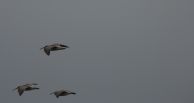Unidentified Storm-Petrels, Puerto Montt, Chile, February, 2009
In early February 2009 our party of four Irish and two United States birders embarked on an exciting twelve day sea-birding voyage from Valparaiso, Chile south around Cape Horn and then north to Buenos Aires, Argentina, taking in various land stops along the route.
- Jim Dowdall, Dublin, Ireland
- Seamus Enright, Kerry, Ireland
- Kieran Fahy, Wexford, Ireland
- Jeff Gilligan, Oregon, USA
- Gerard Lillie, Oregon, USA
- Michael O'Keeffe, Kerry, Ireland
Using the local field guide as reference (Jaramillo et al, 2003) we had noted Valparaiso's position near the southern edge of the expected range for many Humboldt Current seabirds. So, in order to maximize our seabird list a number of us decided to take in a pelagic off Valparaiso a couple of days prior to joining our ship. On the pelagic we encountered a number of storm-petrels which at the time we found very puzzling. They differed subtly from Wilson's Storm-Petrels Oceanites oceanicus familiar to us all from the Northern Hemisphere. The features appeared intermediate between Wilson's and Elliot's (White-vented) Storm-petrel Oceanites gracilis, including quite a delicate "jizz", a relatively narrow wing base and a noticeably pale under-wing panel. Many also displayed a lightly mottled vent/lower belly suggestive of Elliot's. We considered Elliot's a remote possibility off Valparaiso so we were keen to put a name to these birds. After some research we concluded that these must be "Fuegian" Wilson's Storm-petrel O. o. chilensis. Such was the interest sparked by these birds that we began to closely inspect all storm-petrels thereafter. This soon paid off!
On February 4th, following a very rewarding day's land-based birding at Alerce Andino National Park we re-boarded our ship and began journeying south from the city of Puerto Montt through Seno de Reloncaví. Very soon we were encountering our first storm-petrels of the day. Seamus Enright was the first to comment on the extent of white shown by these birds. It was soon apparent that all the birds which we could see well showed lots of white on the vent/belly and on both the upper-wing carpal area and under-wing greater coverts. This pattern was inconsistent with any known taxon - once again we found ourselves puzzled by storm-petrels in Chilean waters. With the light beginning to fade some of us hastily tried to capture images of these birds as we all tried to record what details we could from our perch high up on the bow of the ship.
Description
By sunset we had counted approximately 50 storm-petrels in Seno de Reloncaví. All of those photographed and observed well appeared to be of the same form. Unfortunately the viewing conditions precluded a detailed examination. What follows is a description based on field observations backed up by photographic evidence.
Most striking was the extent of white in the plumage, suggestive initially of one of the Fregetta storm-petrels. However a number of features appeared to rule out that option, including the extent of dark on the flanks and the prominent carpal bar. The birds appeared in fact to be Oceanites Storm-petrels, similar or perhaps slightly stockier than the chilensis Wilson's Storm-petrels which we had been encountering further north. The whitish upper-wing and under-wing panels appeared more striking than on any chilensis we had been observing. The white on the rump appeared to wrap completely around the vent/lower belly, though from photographic evidence it is hard to rule out the presence of perhaps some dark feathering on the sides and centre of the vent (fig. 1).

Fig. 1
Unidentified storm-petrels, Seno de Reloncaví, Puerto Montt, Chile, February 4th 2009. The bird in the upper row of images may be a fresh juvenile while the lower two rows appear to depict adults in moult. Note the extensive white on the vent and lower belly joining the rump. There may be a slight suggestion of dark feathering on the vent. The upper-wing and under-wing bars were both very prominent though these may appear slightly "exaggerated" here due to camera exposure. We advise a degree of caution when analysing these slightly blurred, slightly over-exposed images.
All photos Michael O'Keeffe
Fig. 2 (View Large Version)
Map of Southern South America showing the route of our voyage. Within 24 hours of leaving Valparaiso we had left the expected range of many Humboldt Current species including Elliot's Storm-Petrel. On the 3rd day of the trip we encountered unidentified storm-petrels in Seno de Reloncaví, soon after departing Puerto Montt (see inset).
Fig. 3 (View Large Version)
Artist's impression of the mystery Puerto Montt storm-petrel (bottom) together with chilensis and oceanic/exasperatus Wilson's Storm-petrels and both a typical and an atypical, well-marked example of Elliot's Storm-petrel. The Puerto Montt birds show less white on the belly and more white on the vent than typical Elliot's Storm-petrels. Elliot's also shows a clear divide between belly and rump, along the femoral tract, although this may sometimes be faint or hidden. chilensis is a daintier bird than either oceanicus or exasperatus and shows some plumage features suggestive of Elliot's including pale mottling on the belly and a paler underwing panel. Some indeed suspect chilensis may be closer to Elliot's than Wilson's.
Digital sketch by Michael O'Keeffe.
Discussion
Since our arrival home we have engaged in detailed research into the Storm-Petrels of the Chilean waters. We have spoken to a good number of experts and made some startling discoveries. Our analysis will feature in a future issue of the journal Dutch Birding.
We are hoping that by highlighting these birds to the general birding community others will be on the lookout for these birds and will help shed further light on this interesting puzzle.
Reference
Jaramillo, A., Burke. P. and Beadle, D. 2003. Birds of Chile. Helm Publications, London
(Text and images are all copyright of the authors).

